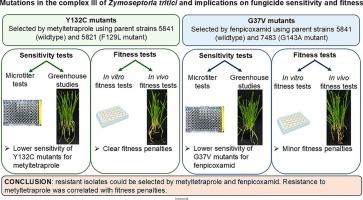小麦酵母菌复合体III突变及其对杀菌剂敏感性和适应性的影响
IF 4
1区 农林科学
Q2 BIOCHEMISTRY & MOLECULAR BIOLOGY
引用次数: 0
摘要
线粒体呼吸链醌外抑制剂(QoI, FRAC Group 11)在控制小麦酵母菌中发挥了重要作用。细胞色素b中G143A突变的进化导致耐药性的发展,导致FRAC组11杀菌剂的有效性丧失。因此,开发了两种新的络合物III抑制剂,甲基四prole和fenpicoxamid。甲基四prole虽然被归类为qi,但由于其独特的化学结构,在G143A突变体上对FRAC Group 11杀菌剂没有交叉抗性。这可以从该化合物在FRAC 11a组中得到反映。Fenpicoxamid作为醌内抑制剂(QiI, FRAC Group 21),由于同一复合物的结合位点不同,不受G143A突变的影响。已经产生了对这两种化合物具有耐药性的实验室突变体:Y132C突变体是由甲基四prole产生的,而G37V突变体是由芬吡肟暴露于野生型菌株或与其他细胞色素b突变(如F129L和G143A)联合产生的。然而,研究表明G143A和Y132C突变不相容。具有Y132C突变的分离株,特别是双突变株F129L + Y132C,在体外和体内对甲基四丙烯的敏感性降低。同时,微滴板竞争试验和温室试验表明,所有Y132C突变体都存在适合度惩罚。由于竞争能力和致病性对分离株的生存至关重要,由于Y132C导致的麦兹虫对甲基四丙烯的抗性不太可能在田间占主导地位,特别是在G143A高频率的种群中。来自野生型和G143A分离株的G37V突变体相对于亲本菌株对芬吡肟胺的敏感性降低,在竞争试验和温室研究中仅表现出轻微的适应性损失。本文章由计算机程序翻译,如有差异,请以英文原文为准。

Mutations in the complex III of Zymoseptoria tritici and implications on fungicide sensitivity and fitness
Quinone outside inhibitors (QoI, FRAC Group 11) of the mitochondrial respiratory chain have played an important role in the control of Zymoseptoria tritici. Evolution of the G143A mutation in cytochrome b led to the development of resistance, resulting in a loss of effectiveness of FRAC Group 11 fungicides. Accordingly, two new complex III inhibitors, metyltetraprole and fenpicoxamid, were developed. Metyltetraprole, although classified as QoI, does not show cross-resistance to FRAC Group 11 fungicides on G143A mutants, due to its unique chemical structure. This is reflected by listing the compound in FRAC Group 11 A. Fenpicoxamid, as a quinone inside inhibitor (QiI, FRAC Group 21), is unaffected by the G143A mutation due to the different binding site at the same complex. Laboratory mutants conferring resistance to both compounds have been generated: Y132C mutants were generated by metyltetraprole and the G37V mutants by fenpicoxamid exposure either in wildtype strains or in combination with other cytochrome b mutations such as F129L and G143A. However, studies indicated an incompatibility between the G143A and Y132C mutations. Isolates with the Y132C mutation, particularly double mutants F129L + Y132C, showed reduced sensitivity to metyltetraprole in vitro and in vivo. Simultaneously, competition trials in microtiter plates and greenhouse tests indicated fitness penalties for all Y132C mutants. Since competitiveness and pathogenicity are crucial for isolate survival, metyltetraprole resistance in Z. tritici due to Y132C is unlikely to become dominant in the field, especially in populations with a high frequency of G143A. G37V mutants derived from both wildtype and G143A isolates exhibited reduced sensitivity to fenpicoxamid relative to their parent strains and demonstrated only minor fitness penalties in competition trials and greenhouse studies.
求助全文
通过发布文献求助,成功后即可免费获取论文全文。
去求助
来源期刊
CiteScore
7.00
自引率
8.50%
发文量
238
审稿时长
4.2 months
期刊介绍:
Pesticide Biochemistry and Physiology publishes original scientific articles pertaining to the mode of action of plant protection agents such as insecticides, fungicides, herbicides, and similar compounds, including nonlethal pest control agents, biosynthesis of pheromones, hormones, and plant resistance agents. Manuscripts may include a biochemical, physiological, or molecular study for an understanding of comparative toxicology or selective toxicity of both target and nontarget organisms. Particular interest will be given to studies on the molecular biology of pest control, toxicology, and pesticide resistance.
Research Areas Emphasized Include the Biochemistry and Physiology of:
• Comparative toxicity
• Mode of action
• Pathophysiology
• Plant growth regulators
• Resistance
• Other effects of pesticides on both parasites and hosts.

 求助内容:
求助内容: 应助结果提醒方式:
应助结果提醒方式:


